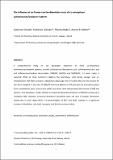| dc.contributor.author | Gniado, Katarzyna | |
| dc.contributor.author | Löbmann, Korbinian | |
| dc.contributor.author | Rades, Thomas | |
| dc.contributor.author | Erxleben, Andrea | |
| dc.date.accessioned | 2017-05-23T13:55:58Z | |
| dc.date.available | 2017-05-23T13:55:58Z | |
| dc.date.issued | 2016-03-16 | |
| dc.identifier.citation | Gniado, Katarzyna, Löbmann, Korbinian, Rades, Thomas, & Erxleben, Andrea. (2016). The influence of co-formers on the dissolution rates of co-amorphous sulfamerazine/excipient systems. International Journal of Pharmaceutics, 504(1–2), 20-26. doi: https://doi.org/10.1016/j.ijpharm.2016.03.023 | en_IE |
| dc.identifier.issn | 1873-3476 | |
| dc.identifier.uri | http://hdl.handle.net/10379/6538 | |
| dc.description.abstract | A comprehensive study on the dissolution properties of three co-amorphous sulfamerazine/excipient systems, namely sulfamerazine/deoxycholic acid, sulfamerazine/citric acid and sulfamerazine/sodium taurocholate (SMZ/DA, SMZ/CA and SMZ/NaTC; 1:1 molar ratio), is reported. While all three co-formers stabilize the amorphous state during storage, only co-amorphization with NaTC provides a dissolution advantage over crystalline SMZ and the reasons for this were analyzed. In the case of SMZ/DA extensive gelation of DA protects the amorphous phase from crystallization upon contact with buffer, but at the same time prevents the release of SMZ into solution. Disk dissolution studies showed an improved dissolution behavior of SMZ/CA compared to crystalline SMZ. However, enhanced dissolution properties were not seen in powder dissolution testing due to poor dispersibility. Co-amorphization of SMZ and NaTC resulted in a significant increase in dissolution rate, both in powder and disk dissolution studies. (C) 2016 Elsevier B.V. All rights reserved. | en_IE |
| dc.description.sponsorship | This work was supported by Science Foundation Ireland under Grant No. [07/SRC/B1158] as part of the Synthesis and Solid State Pharmaceutical Centre (SSPC). | en_IE |
| dc.format | application/pdf | en_IE |
| dc.language.iso | en | en_IE |
| dc.publisher | Elsevier | en_IE |
| dc.relation.ispartof | International Journal Of Pharmaceutics | en |
| dc.rights | Attribution-NonCommercial-NoDerivs 3.0 Ireland | |
| dc.rights.uri | https://creativecommons.org/licenses/by-nc-nd/3.0/ie/ | |
| dc.subject | Co-amorphization | en_IE |
| dc.subject | Dissolution studies | en_IE |
| dc.subject | Dispersibility | en_IE |
| dc.subject | Sulfamerazine | en_IE |
| dc.title | The influence of co-formers on the dissolution rates of co-amorphous sulfamerazine/excipient systems | en_IE |
| dc.type | Article | en_IE |
| dc.date.updated | 2017-05-18T08:09:34Z | |
| dc.identifier.doi | 10.1016/j.ijpharm.2016.03.023 | |
| dc.local.publishedsource | https://doi.org/10.1016/j.ijpharm.2016.03.023 | en_IE |
| dc.description.peer-reviewed | peer-reviewed | |
| dc.contributor.funder | |~| | |
| dc.internal.rssid | 11047578 | |
| dc.local.contact | Andrea Erxleben, School Of Chemistry, Room 150, Arts/Science Building, Nui Galway. 2483 Email: andrea.erxleben@nuigalway.ie | |
| dc.local.copyrightchecked | No | |
| dc.local.version | ACCEPTED | |
| nui.item.downloads | 486 | |


